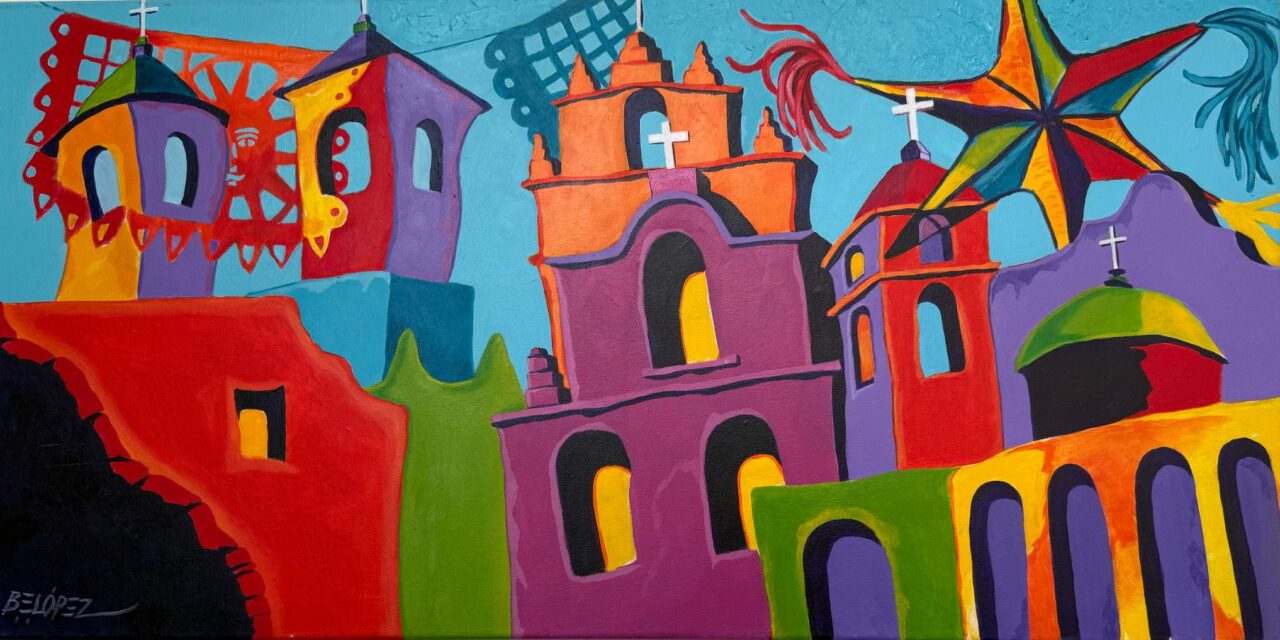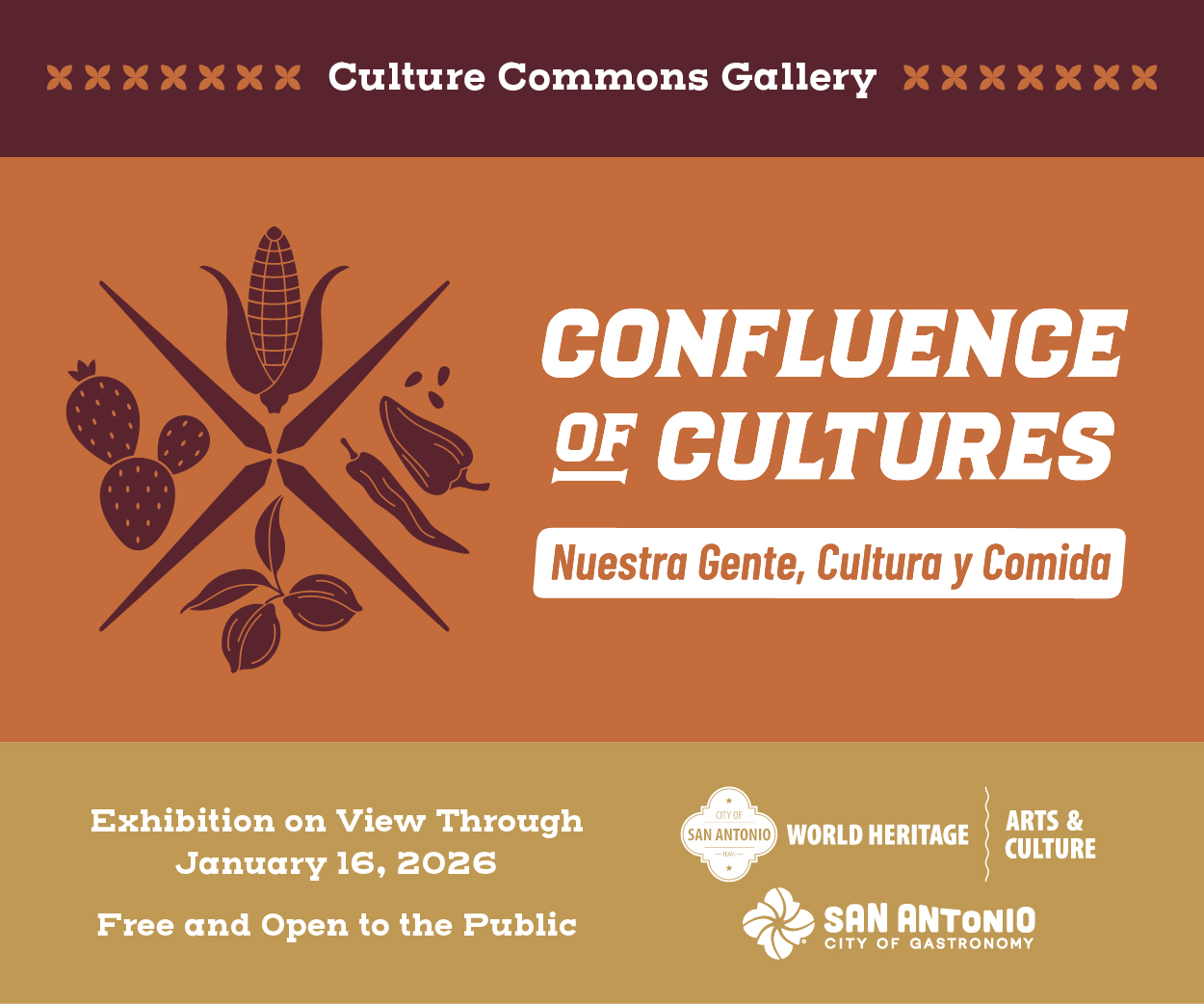To honor the upcoming 10th anniversary of San Antonio’s World Heritage designation, including a UNESCO Creative Cities Network in gastronomy, the City Arts and Culture Office joined with the local World Heritage team to celebrate “dynamic, diverse, and vibrant cultural heritage through the lens of local artistry.” The Confluence of Cultures: Nuestra Gente, Cultura y Comida exhibit at the Plaza de Armas showcases the art work of twenty San Antonio artists.
Native Americans [Natives] first settled the region of South Texas twelve thousands years ago. Their ancestors migrated across the Bering Strait over the period 30,000 and 10,000 BC. The local descendants of those Natives crossing the land bridge from Asia into North America are the true discoverers and original settlers of Texas. The Natives cultivated many food sources including the three sisters of intercropping–maize [corn], beans, and squash.
They also harvested wild rice, sweet potatoes, cacao, and sunflower seeds. The Indigenous people introduced the Europeans to plants and fruits that grew naturally in the region, such as pecans, avocado, and nopales [cacti].
The first Spanish explorers of Texas in the early 1500s, beginning with Francisco Coronado in 1540, were only interested in finding gold. The task of establishing the first Spanish towns, presidios, and missions fell to padres and soldiers arriving in the period between 1690 and 1750. These early Spanish settlers occupied the land with the purposes of claiming the region for the King of Spain, Christianizing the Natives, and extracting wealth from the conquered territory. When South Texas proved barren of mineral wealth, the region grew slowly. The gold seekers passed through Texas while the Spanish priests stayed to administer religious services and provide Christian education to the Natives.
The art exhibit Confluence of Cultures: Nuestra Gente, Cultura y Comida recognizes that “the arrival of the Spanish created an interweaving of cultures whose tangible remnants can still be seen today and are evident in the art, architecture, and archeology.” The newcomers introduced new flavors, spices, and ingredients from Europe, Asia, and Africa, along with new cooking methods and preservation techniques. The United Nations Educational, Scientific and Cultural Organization (UNESCO) designated the five San Antonio Missions as a World Heritage Site in 2015. San Antonio is the only city in the United States that is home to a UNESCO World Heritage site and is also named a UNESCO Creative City of Gastronomy.
The UNESCO Creative Cities Network (UCCN) in the field of gastronomy promotes collaboration among cities that use their culinary heritage and creativity as tools for sustainable urban development. To be designated as part of the Creative Cities Network, San Antonio had to meet specific UNESCO criteria, including a well-developed gastronomy characteristic of the region, a vibrant culinary community with traditional restaurants and chefs, and use of Indigenous ingredients and traditional cooking methods.
The Confluence of Cultures: Nuestra Gente, Cultura y Comida exhibit features San Antonio artists who explore the ways merging cultures have shaped their homes and experiences. For the Confluence exhibit, oil painter Eva M. Sanchez, a native of San Antonio, created 20 small paintings of herbs and plants, such as radish, squash, chile pepper, pecan, and tomatoes– mainstays of Mexican cooking. There is also a butterfly hovering over a blue blossom and a bright red rooster. Eva Sanchez explained to art critic Wendy Bowman Butler, “My work is a celebration of cultural identity. I paint food because it’s so closely tied to how I experience and think about my culture.” While Sanchez is best known for her photorealism of Mexican food, she is also a highly accomplished muralist.
Sanchez grew up on San Antonio’s Southside and at age 16 began additional art training at the Southwest School of Art. Following her graduation from Earlham College [Richmond, Indiana] in 2013, she spent nine months in Mexico City studying Spanish, Mesoamerican art, and art conservation. In Mexico City she expanded her interest in food and culture. She believes there is beauty in everyday food objects and is known for larger-than-life paintings of South Texas products such as Mexican pan dulce, paletas, and salsa or fruit cups.
Sanchez’s food artwork is also about making us look and think about something tasty and delightful. To do this, Sanchez relies heavily on color selection and exemplary technique and execution. Art critic Butler wrote, “Sanchez is a hyper realistic painter who investigates cultural identity through the fusion of man-made and organic materials. Her color, precision, and larger than life canvases create a sensory explosion for the viewer.”
Ashley Perez, also a local artist, specializes in painting and drawing and received her first formal training in art at SAY Si, a nonprofit youth art program in San Antonio. She earned her B.F.A. in painting from the University of Texas at San Antonio in 2010. She describes the goal of her four paintings of food and landscape as exploring “themes of land use, sustainability and human resources development aligning with UNESCO’s goals.”
In her artist statement, Perez explains the concept of companion planting in which certain plants thrive together supporting each other’s growth–as seen in the “Three Sisters”–squash, corn, and beans. The “Three Sisters” planting method originated in Mesoamerican and was adopted by Indigenous people across North America. It involves the interplanting of maize, beans, and squash in a symbiotic relationship that maximizes soil fertility, conserves resources, and enhances crop yields. In two of her paintings, Perez also includes birds, the ultimate pollinators in the gardens of the “Three Sisters.”
A painting in a three-dimensional glass box by
Adriana Garcia features a family dining inside their modest home on the outskirts of San Antonio. According to Garcia, the painting honors “the foods of our
Yanaguana [Indigenous tribe] ancestors, like yucca, pecan, mesquite beans, prickly pears, fish, and rabbit.” The artwork shows the inside of a dining room where a grandmother serves a family dinner. The artist also painted scenes in the glass box depicting areas outside the house including the San Antonio River nearby with turtles, frogs, and rabbits on the banks. In the far distance, one can see the San Antonio skyline.
The preparation of food was the subject of several artists, including Kat Cadena, a University of Texas at San Antonio graduate. An artist, muralist, and illustrator, Cadena acknowledges the proud mestiza women who raised her. She also dedicated a painting to her herbalism mentor, Beto Davila De Leon. In her painting “Beto Making Pinole de Nuez,” Cadena notes that “Beto carries on the legacy of traditional foodways from generations past in the South Texas region, grinding pecans to make pinole de nuez.” The curators noted that Cadena’s works “are a nod to a simultaneous keeping of tradition and an international breaking of cycles.”
Daniela Talamantes Martinez, a graduate of UT Austin, captures the tradition of preparing barbacoa in a South Texas family backyard, noting that gathering around a fire has been a human ritual for centuries. Barbacoa is traditionally prepared by placing a cow’s head in a deep hole dug in the earth and cooked with ample burning wood. Sufficient wood or charcoal is placed in the ground oven to last overnight. I was fortunate to have prepared
barbacoa in our backyard with my dad, allowing the meat to cook for hours, a process that resulted in very tender beef rolled into corn tortillas.
Martinez painted whirling smoke moving up from the barbacoa pit to an impressionistic blue sky–a South Texas version of Van Gogh’s “Starry Night.” The
multigenerational scene includes youngsters, middle-aged parents, and grandparents. A bag of charcoal is nearby and a young man uses a shovel to add fuel to the fire. Numerous families sit in the backyard plus the family dog, several cats, and a table hosting a Big Red soda.
The paintings in the Confluence of Cultures: Nuestra Gente, Cultura y Comida masterfully explore themes of food and culture in South Texas. Located in the Plaza de Armas Building, the exhibit is on display until January 16, 2026.






